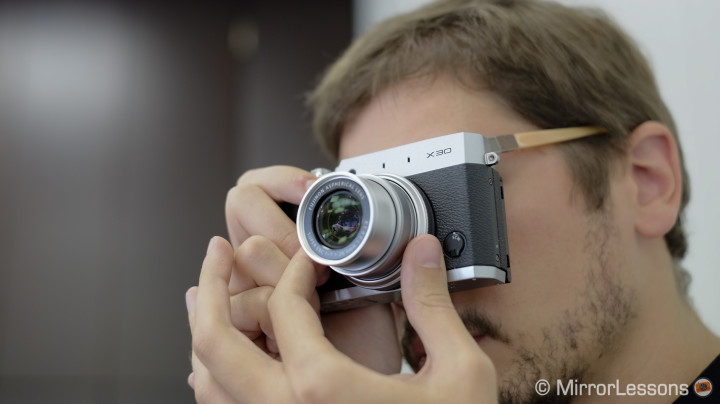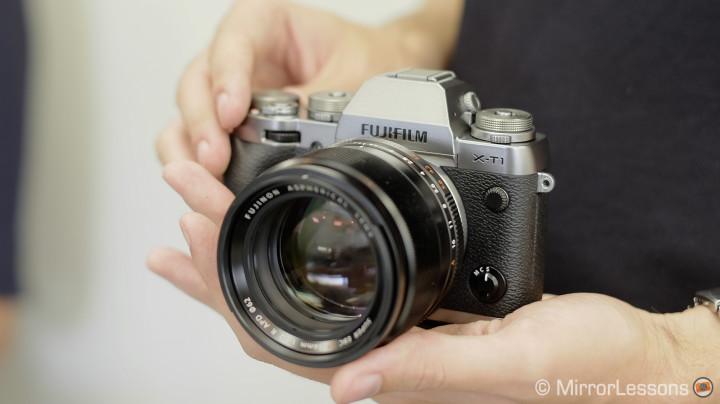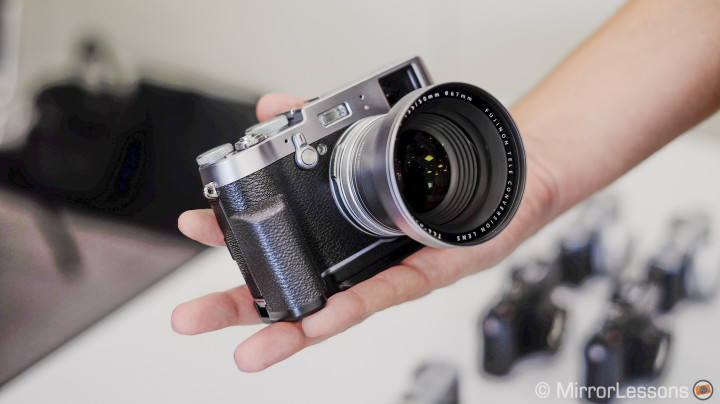Our first day at Photokina has been very exciting. After starting the day by interviewing three Senior Managers from Sony Japan, we went to the Fujifilm media session to discover the latest products announced a few days before the start of the event. After the presentation held by several managers from Fujifilm Japan, my heart naturally directed me towards the new X100T. Its predecessor is my favourite X camera to date and the first thing I wanted to check is whether that great feeling I had the first time I held it could be improved with this new version.
Note: during an event like Photokina, it is difficult to test cameras and lenses properly. During private sessions, time is usually limited while at the dedicated booths you can’t leave the desk. As such, there is little to photograph that can make sense in a real world situation. Moreover, you usually aren’t allowed to use your SD card and bring pictures home with new products. This is why I prefer not to cover all the new details about each camera (I’ll link to our press release articles) but instead concentrate on a more practical approach: how it feels and why it could be worth testing the camera further.
A question of feeling: the new X100T
At first glance, the new Fujifilm X100T and X30 might appear to be a good improvement over the preceding models but with nothing new and exciting like, for example, a new sensor. Until you try the camera, you don’t realise that these updates, small as they may be, are actually important.
With the X100T, the first thing I looked at was the new hybrid viewfinder and I can only praise Fujifilm for improving this unique technology. When you toggle the dedicated lever to the left to activate the new live view focus area, it feels like a “true hybrid viewfinder”. I always liked the possibility to switch between optical and electronic on the X-Pro1 and the X100s but found the OVF limiting. I would eventually end up using only the EVF because of the absence of parallax issues.

The X100T has given its users a new experience with the OVF. The ability to use a real optical viewfinder while checking focus with a live view positioned at the bottom left is an innovative new way of framing your photograph. Fujifilm calls it the first electronic rangefinder. Also, the OVF gives you a real time parallax correction with the white rectangular margins moving in the viewfinder according to the focus distance. With this update, the Fujifilm hybrid viewfinder is finally mature, and offers a better and more complete user experience.

There is however one doubt in my mind, and it regards the long-term practicality of the OVF. At first, you can’t help but feel great excitement about using the new OVF because of the live view technology that encourages you to use manual focus more on the X100T. But it also requires a lot of concentration with all the information displayed: you have to check focus on the bottom left, while keeping track of the parallax area plus the usual settings available in the viewfinder, as well as your actual composition. Yes, the technology is great, but at the same time I wonder if this optical viewfinder would end up being more tiring to use than the EVF after an extensive period of time.
Of course, the live view area can be deactivated and you can use the OVF or the EVF normally like on the X100s or X100. You can also switch from one to the other depending on your needs. When the autofocus with the OVF fails, the manual focus option works quickly and efficiently without the need to switch to the EVF. The live view area seems useful mostly for manual focus work: you can choose to display magnification, peaking or digital split image in the live view are.
Among the other improvements I noticed right away, we have the LCD. I quickly realised that the LCD has a better resolution, and the same thing applies to the EVF, which seems to keep a very reasonable time lag in low-light environment. Also, the automatic brightness seems very responsive.
The overall feeling is the same as the X100s regarding its ergonomics. The button layout on the rear has been updated so it might take some time to adapt to it, but it seems more cleverly designed. I did appreciate the new landscape grip to hold the camera sturdily. There are several alternative grips on the market including the excellent PhotoMadd Grips.
You can read about all the improvements on the X100T in our press release article.
A question of feeling: the new X30
The same feeling I had with the X100T happened also with the X30. Actually amongst all the new Fujifilm products announced, the X30 is the camera that I liked the most. I appreciated the X20 in the past but didn’t really fall for it. As soon as I grabbed the X30, it was clear to me that going with an EVF is the best choice Fujifilm could have made. Let’s face it, the optical viewfinder of the X20 was usable only in certain situations due to the parallax issue, and you don’t want such an important feature to not be 100% reliable. This changes with the X30: it has a bright, big high resolution viewfinder and it is a joy to use. It is a very high quality viewfinder with 2.36 M-dots, a 0.005s display lag and 0,65x magnification. It just makes sense.

The new function ring also makes the usability of the camera much quicker and more efficient. While the dedicated zoom ring also turns on a camera like the X20, the second ring (also made of metal) can change aperture, shutter speed, white balance, ISO and other functions. It is very precise and nice to turn. The easily accessible button on the front let you quickly switch the function of the ring.
Amongst other things worth of notice, the autofocus seemed faster than the X20 and the new multi-point mode seems to work well and efficiently on the few subjects I tried in the poorly-lit press room.

Like the X100T, there is a new display layout when you choose to disable the live view on the LCD. It also shows you the configurations of the “Q” button.
You can read about all the improvements on the X100T in our press release article.
The X-T1 Graphite Silver: beautiful but not necessary
When I first saw the official product images, the look didn’t convinced me. But when you see an object in real life, you can easily change your opinion and this is what happened with the new X-T1: it is indeed a very beautiful camera design and those who seek this kind of characteristic will certainly appreciate this nice special finish whose production required 6 different steps. All the dials are made of metal including the metering and drive subdials (unlike the X-T1 black). The button layout hasn’t changed and this includes the highly controversial arrow pad.


But in total honesty once you finish admiring its aesthetics, there isn’t much to add. All the new features the camera includes will also be available for the black X-T1 in mid-December via firmware updates and that includes the electronic shutter. Therefore the only motivation you might have to choose the Silver X-T1 over the black version is the design (and the difference of a few extra bucks).
Conclusion: evolution to revolution
Fujifilm’s new motto seems to indicate that for the revolution to happen, products need to evolve first. The X100T and X30 are good examples of this philosophy. But marketing aside, it doesn’t mean that current X20 and X100/X100s users need to upgrade. If you don’t use the OVF a lot on the X100/X100s perhaps you won’t benefit much. The other features like the completely silent shutter and 1/32000s of speed are nice if you find good opportunities to use it.
The new “Classic Chrome” film simulation mode is also interesting, at least as far as the concept behind it goes. Fujifilm developed it to respond to the request of many photojournalists who wanted something with less saturation and strong shadows to work with. The classic chrome is meant to let the photograph express the feeling and atmosphere of the scene more, or the expression on people’s faces. It is interesting to see that we have a camera brand that will release such a colour profile, which actually isn’t based on film at all, while many other brands concentrate on giving a highly saturated and contrasty look to their images.
The X30 and X100T might not be essential but they are interesting updates from their predecessors and have taken Fujifilm a step closer to perfection. Let’s hope that the real revolution isn’t far off.


